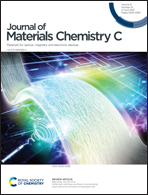Significantly tailored energy-storage performances in Bi0.5Na0.5TiO3–SrTiO3-based relaxor ferroelectric ceramics by introducing bismuth layer-structured relaxor BaBi2Nb2O9 for capacitor application
Abstract
Dielectric capacitor materials with remarkable energy storage density, remarkable power density, and outstanding charging–discharging performance have always been the focus of research. Lead-free Bi0.5Na0.5TiO3-based (BNT) relaxors have been deemed as potential dielectric capacitor materials on account of the large maximum polarization (Pmax). However, compared to the wildly studied Pb-based relaxors, the energy density and efficiency of the most reported BNT-based relaxors are still unsatisfactory. In this research, an innovative strategy was designed to improve the energy storage properties of Bi0.5Na0.5TiO3–SrTiO3 (BNT–ST)-based relaxor ferroelectric ceramics, in which the bismuth layer-structured relaxor BaBi2Nb2O9 (BBN) was adopted as the modifier. It was found that the addition of BBN effectively enhanced the relaxation behavior of the BNT–ST ceramic and significantly improved the breakdown strength (BDS), resulting in a remarkable energy storage performance with a high recoverable energy storage density (Wrec) of 3.97 J cm−3 and a high efficiency (η) of 81% was obtained in the 0.98(BNT–ST)–0.02BBN ceramic. Moreover, the ceramic also exhibited good thermal and frequency stabilities, favorable fatigue endurance, along with an ultra-short discharge time (t0.9 – 0.30 μs), a sizable current density of 509.5 A cm−2, and an outstanding power density of 30.57 MW cm−3. All these results suggest the great potential of the BBN-modified BNT–ST ceramics in the energy storage application field. Ultimately, this research also indicates that the BLSF is an active modifier to tailor energy storage properties of the perovskite-structured BNT-based ceramic, which provides a referential idea for the further development of BNT-based energy storage materials.



 Please wait while we load your content...
Please wait while we load your content...